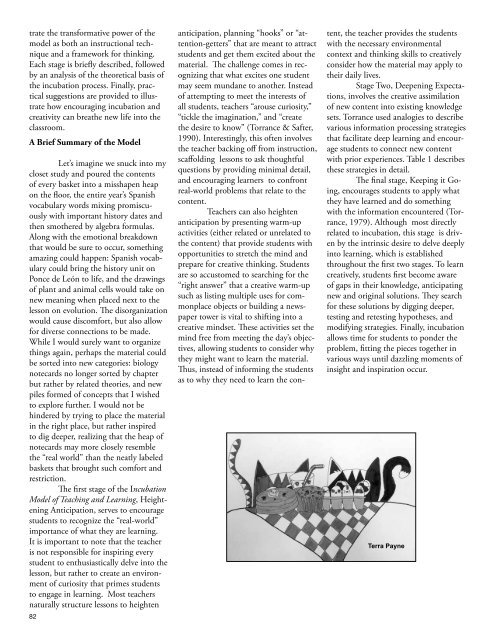Torrance Journal for Applied Creativity
TorranceJournal_V1
TorranceJournal_V1
Create successful ePaper yourself
Turn your PDF publications into a flip-book with our unique Google optimized e-Paper software.
trate the trans<strong>for</strong>mative power of the<br />
model as both an instructional technique<br />
and a framework <strong>for</strong> thinking.<br />
Each stage is briefly described, followed<br />
by an analysis of the theoretical basis of<br />
the incubation process. Finally, practical<br />
suggestions are provided to illustrate<br />
how encouraging incubation and<br />
creativity can breathe new life into the<br />
classroom.<br />
A Brief Summary of the Model<br />
Let’s imagine we snuck into my<br />
closet study and poured the contents<br />
of every basket into a misshapen heap<br />
on the floor, the entire year’s Spanish<br />
vocabulary words mixing promiscuously<br />
with important history dates and<br />
then smothered by algebra <strong>for</strong>mulas.<br />
Along with the emotional breakdown<br />
that would be sure to occur, something<br />
amazing could happen: Spanish vocabulary<br />
could bring the history unit on<br />
Ponce de León to life, and the drawings<br />
of plant and animal cells would take on<br />
new meaning when placed next to the<br />
lesson on evolution. The disorganization<br />
would cause discom<strong>for</strong>t, but also allow<br />
<strong>for</strong> diverse connections to be made.<br />
While I would surely want to organize<br />
things again, perhaps the material could<br />
be sorted into new categories: biology<br />
notecards no longer sorted by chapter<br />
but rather by related theories, and new<br />
piles <strong>for</strong>med of concepts that I wished<br />
to explore further. I would not be<br />
hindered by trying to place the material<br />
in the right place, but rather inspired<br />
to dig deeper, realizing that the heap of<br />
notecards may more closely resemble<br />
the “real world” than the neatly labeled<br />
baskets that brought such com<strong>for</strong>t and<br />
restriction.<br />
The first stage of the Incubation<br />
Model of Teaching and Learning, Heightening<br />
Anticipation, serves to encourage<br />
students to recognize the “real-world”<br />
importance of what they are learning.<br />
It is important to note that the teacher<br />
is not responsible <strong>for</strong> inspiring every<br />
student to enthusiastically delve into the<br />
lesson, but rather to create an environment<br />
of curiosity that primes students<br />
to engage in learning. Most teachers<br />
naturally structure lessons to heighten<br />
82<br />
anticipation, planning “hooks” or “attention-getters”<br />
that are meant to attract<br />
students and get them excited about the<br />
material. The challenge comes in recognizing<br />
that what excites one student<br />
may seem mundane to another. Instead<br />
of attempting to meet the interests of<br />
all students, teachers “arouse curiosity,”<br />
“tickle the imagination,” and “create<br />
the desire to know” (<strong>Torrance</strong> & Safter,<br />
1990). Interestingly, this often involves<br />
the teacher backing off from instruction,<br />
scaffolding lessons to ask thoughtful<br />
questions by providing minimal detail,<br />
and encouraging learners to confront<br />
real-world problems that relate to the<br />
content.<br />
Teachers can also heighten<br />
anticipation by presenting warm-up<br />
activities (either related or unrelated to<br />
the content) that provide students with<br />
opportunities to stretch the mind and<br />
prepare <strong>for</strong> creative thinking. Students<br />
are so accustomed to searching <strong>for</strong> the<br />
“right answer” that a creative warm-up<br />
such as listing multiple uses <strong>for</strong> commonplace<br />
objects or building a newspaper<br />
tower is vital to shifting into a<br />
creative mindset. These activities set the<br />
mind free from meeting the day’s objectives,<br />
allowing students to consider why<br />
they might want to learn the material.<br />
Thus, instead of in<strong>for</strong>ming the students<br />
as to why they need to learn the content,<br />
the teacher provides the students<br />
with the necessary environmental<br />
context and thinking skills to creatively<br />
consider how the material may apply to<br />
their daily lives.<br />
Stage Two, Deepening Expectations,<br />
involves the creative assimilation<br />
of new content into existing knowledge<br />
sets. <strong>Torrance</strong> used analogies to describe<br />
various in<strong>for</strong>mation processing strategies<br />
that facilitate deep learning and encourage<br />
students to connect new content<br />
with prior experiences. Table 1 describes<br />
these strategies in detail.<br />
The final stage, Keeping it Going,<br />
encourages students to apply what<br />
they have learned and do something<br />
with the in<strong>for</strong>mation encountered (<strong>Torrance</strong>,<br />
1979). Although most directly<br />
related to incubation, this stage is driven<br />
by the intrinsic desire to delve deeply<br />
into learning, which is established<br />
throughout the first two stages. To learn<br />
creatively, students first become aware<br />
of gaps in their knowledge, anticipating<br />
new and original solutions. They search<br />
<strong>for</strong> these solutions by digging deeper,<br />
testing and retesting hypotheses, and<br />
modifying strategies. Finally, incubation<br />
allows time <strong>for</strong> students to ponder the<br />
problem, fitting the pieces together in<br />
various ways until dazzling moments of<br />
insight and inspiration occur.<br />
Terra Payne


